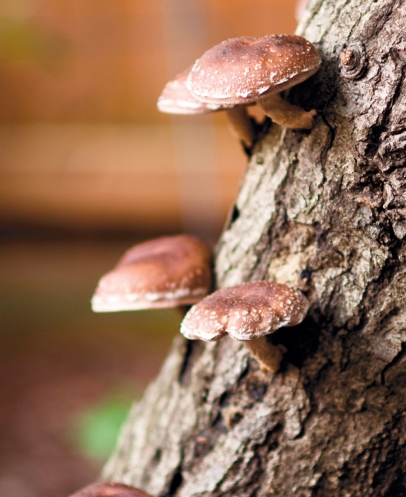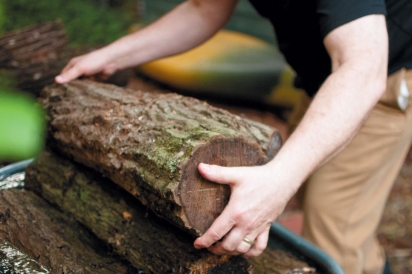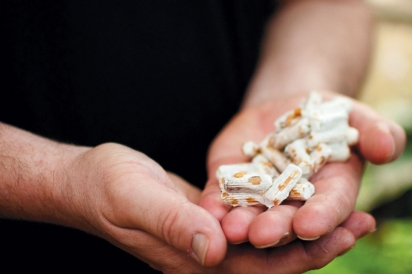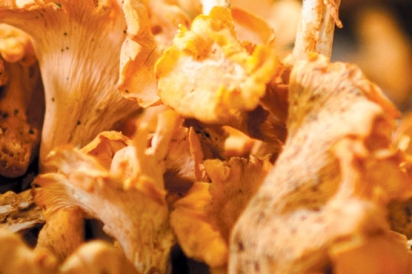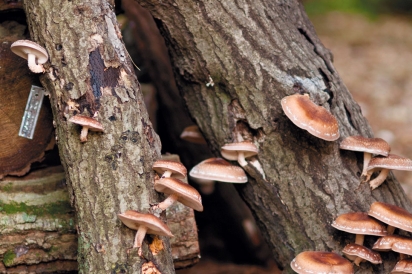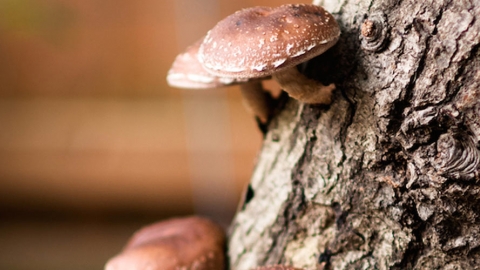Mindful About Mushrooms
Local grower Michael Hayes and his backyard kingdom of edible mushrooms
Behind a quaint house in Clintonville shrouded in lush summer growth, there’s magic at work at the home of Michael Hayes. A pile of oak, maple, and mulberry logs, each perforated with dozens of holes, is neatly stacked at the base of a towering pine tree. More lean against the trunk. The ground is soft after weeks of steady rains. Sunlight is patchy, but the shade has its purpose. All the better for the tiny threads of mycelium packed tightly into each log, ready to explode from the bark as mushrooms.
Michael is vivacious. His passion for the mushrooms is rivaled only by his admiration of the growing process, one that hastens what will occur naturally when wood, water, spores, and time are left to their own devices.
For 24 years Michael and his wife Cynthia have lived in their Clintonville home, a corner bungalow flanked by tall trees.
“That’s why we chose this house,” Michael says. “We drove through the neighborhood and just loved the trees. It felt substantial.” For the past five years, Michael has cultivated edible mushrooms in their backyard, not for sale but for personal enjoyment, save for the occasional trade with a neighbor. Michael, an architect by trade, has always been a gardener.
“When I was a little boy I collected mushrooms in the forest with my grandmother who was this old, wonderful Polish lady. We’d collect grocery bags full,” he says, holding his arms out wide for emphasis, supporting the imaginary weight of the mushrooms. “She knew just what to take in the forest.”
“I grew up eating mushrooms. We always had a garden. So I guess the whole thing came from my interest in horticulture,” he says.
Michael first cultivated mushrooms as a side project—a way to grow the mushroom varieties he enjoyed eating most, shiitake and grey oyster—and eventually realized growing mushrooms is easy. “It’s not that hard,” Michael says. “You can grow mushrooms in coffee grounds, in rolls of toilet paper. There’s a very easy methodology for doing it. There’s whole kits you can get,” he adds.
Michael’s logs come from an oak felled on a friend’s land. “They said ‘pick a tree, any tree’ and I picked a nice white oak, a beautiful straight tree,” he says, looking up at the slender pine off his shoulder. After all, shiitake means “oak flower” in Japanese. Michael then drills holes in a diamond pattern into each log before pushing inoculated wooden dowels, just like the ones used to build furniture, into the holes.
“That’s mycelium,” Michael says, cupping a few dowels in his palm before settling them back into a bag he ordered from an online mushroom retailer. “Depending on the size of the log, there may be between 40 to 60 spawn plugs in each log.”
He’ll seal the pegs into the holes with wax, creating the right environment for growth. Thus begins the year-long process of inoculation in which the mushroom spores slowly colonize the log, laying the ground work for years of growth to come. A log, once inoculated, will produce for five to seven years. But patience is a crucial factor.
Then, one by one, he drops the logs into a metal trough filled with recycled rainwater. “By soaking them the water is absorbed and production is stimulated. The mycelium says, ‘Oh, it’s raining outside. It’s time to flower,” Michael says.
Michael leads the way through the backyard thick with vegetation, much of it edible. Inside a low wooden fence, the garden thrives. Carrot tops are as vibrant as kale. Micro-greens grow in small clay pots at the fence line. Michael shows off healthy tomato plants grown from the seeds of a feisty volunteer that shot up between two cobblestones last year. It’s nearly transformative, the greenery.
“It all comes down to health, right? I want to know what I eat so that’s what started this whole thing, educating myself about “you are what you eat,” so I try to grow my own food as much as possible in my little yard,” he says, proudly. There is little space he has not laid his hands on.
Michael savors the process. As a student of classical architectural and a general practitioner today, he guides structures of varying size from infancy to opening. Just as small glimmers of life peek through the dampened logs as the fungi forms, so too does a building take a slow and careful shape.
“Everything overlaps in my life,” Michael says. “I think it was Frank Lloyd Wright that said a good architect should be able to design a fork as well as a city. Design at every scale. I don’t see any distinction. Things overlap for me a lot, horticulture with architecture,” he says.
“Mushrooms are integrated with my gardening. I compost. I’ve got worms in the basement—vermiculture. That takes me through the winter, I’ve got compost here in the backyard,” he says.
“Our volume of compostables has really grown since we gave up most processed foods. And it turns out compost makes the best soil, so my garden is augmented with the compost, with the worm casings, all that stuff. My point is everything integrates. Everything’s tied together. If you follow nature’s guide you can’t go wrong.”
Michael wants to build more than a varied garden. He wants to build a legacy of mindful growing and eating.
“I am teaching my daughters,” Michael says. “That’s a big thing for me, that they know this and can carry it on.”


